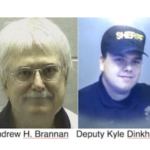Surviving a Police Encounter – Part 2 Caring
Surviving a Police Encounter
Part 2: Caring About the Officer’s Safety

On January 12, 1998, Deputy Kyle Dinkheller pulled over a speeding motorist in what, at first, appeared to be a routine traffic stop. Dinkheller activated his dash camera, and over the next three and a half minutes, it recorded every patrol officer’s worst nightmare. The motorist, who had exited the vehicle, quickly became uncooperative, and when he heard Dinkeheller radio for backup, he charged at the deputy who beat him off with his baton.
The motorist returned to his white pickup truck, retrieved an Iver Johnson M1 carbine, and in the ensuing gunfight, he shot the deputy 10 times, including a fatal shot through Dinkheller’s right eye. The camera recorded Dinkheller’s terrified screams during the final desperate moments of his life. It was one of the first dash-cam videos to “go viral” on the pre-YouTube internet, and practically every patrol officer in the country learned the name Kyle Dinkheller.
23 years later, on February 4, 2021, New Mexico State Police Officer Darian Jarrott pulled over a motorist (who also happened to be driving an inconspicuous white pickup truck). The stop, which at first appeared routine, ended with the driver exiting the vehicle with an AR-15-style rifle and murdering the officer. Like the Dinkheller murder, the encounter lasted just over three and a half minutes.
The Federal Bureau of Investigation reported that in 2020, “44 law enforcement officers were feloniously killed in the line-of-duty.” Patrol officers understand all too well that routine traffic stops can turn deadly in a matter of moments. It’s understandable, therefore, that a law enforcement officer may approach a traffic stop with some trepidation. Conversely, The Washington Post maintains a database of “every fatal shooting by an on-duty police officer in the United States.” In 2020, they reported 1021 deaths. The database also shows that Black and Hispanic men are killed at a disproportional rate compared with the rest of the population. News coverage of civilians, often unarmed, being killed during police encounters has been unceasing. It’s understandable, then, that civilians are also justifiably trepidatious about traffic stops — especially Black and Hispanic civilians.
Retired Oklahoma City Police Lieutenant Stan Campbell has trained officers for over 25 years and had his fair share of traffic encounters with civilians, and he knows firsthand the anxiety officers feel. He’s also a Black man and the father of a son, and as such, he understands the apprehension citizens feel during the same encounters. “We see a situation where there are two scared people in a legal stop,” Stan says, “where they are both fearful of each other, and they may even hate each other because of the stories they have heard, or the experiences of the individual from the past.”
Attorney Lorenzo Banks is a criminal defense attorney in Oklahoma City, and he represents citizens with civil rights claims against officers who overstepped their authority our used unjustifiable force. Lorenzo acknowledges that “the overwhelming majority of officers are great officers and they just want to protect and serve the community.” “Just like you get nervous when you’re getting pulled over at two o’clock in the morning, this officer’s kinda nervous,” Lorenzo says. “He wants togo home. She wants to go home to her son. He wants to go home to his spouse.”
Lorenzo has joined Stan to spread the word about D.O.P.E. the Movement with the goal of educating police and citizens alike about De-escalating Officer Patrol Encounters. As part of the effort, Stan has developed “The Three Cs” for surviving a police encounter with your rights intact: Caring, Communication, and Compliance. Because law enforcement officers are in a position of authority, because their job is to serve the community, and because they have specialized training, we hold them to a higher standard. We expect law officers to care, to communicate, and to respect the rights of citizens, and D.O.P.E. The Movement has outreach designed specifically for reinforcing this message within law enforcement agencies. Nonetheless, the actions of citizens have a significant impact on how a patrol encounter unfolds, and “The Three Cs” are designed specifically to help citizens survive law enforcement encounters with their rights intact.
The first “C” is “Caring,” and it means that the citizens in a traffic stop understand that the officer they’re about to encounter has a reason to be nervous, and they want to demonstrate they care about the officer’s safety. There are some very simple things you can do at the beginning of an encounter to demonstrate that you intend to make the encounter safe for the officer.
It all starts with pulling over right away once an officer signals with emergency lights for you to stop. Stan says that some people have gotten bad advice regarding using too much discretion about when and where to pull over, such as waiting until they get to a well-lit area — someplace where the driver may feel more comfortable. Stan says, “If an officer has told you to pull over, and he has the lights on, and you lead him to a different location, then you’re pushing him to an anxiety moment because he or she doesn’t know why you’re not stopping.” Officers are strategic about when they signal a traffic stop, often waiting to engage the lights until they are at a place where they feel safe.
Once you’ve pulled over into a place where the officer is safe from other traffic, it’s important to make sure the officer can see your hands. Stan says, “Police officers are taught that a person’s hands are what’s going to kill you.” If you go out of the way to allow an officer to see your hands, you are demonstrating that you are unarmed, that you understand that the officer wants to see your hands, and that you care enough to proactively demonstrate that you are not a threat.
Lorenzo Banks says that a motorist’s demeanor is important during a traffic stop. There’s no law that you have to be nice to a law enforcement officer. In fact, legally, you can swear at an officer and yell in his or her face, but that obviously doesn’t help de-escalate the encounter. If a motorist cares about an officer’s safety, they will act respectfully and calmly. Very frequently, an officer will match the tone of the driver — it’s human nature. Beginning a law enforcement encounter respectfully and calmly can go a long way to ensuring that it ends that way as well.
Caring begins with empathy, and it’s important for citizens to realize that law enforcement officers risk their lives to do their job, knowing that any given traffic stop holds the possibility of quickly devolving into a deadly encounter. Acknowledging that risk by pulling over quickly and in a safe place establishes a good foundation for the following interaction. Keeping your hands in plain view and adopting a calm respectful demeanor sends a signal to the officer that they have nothing to worry about from you. Behaving this way doesn’t guarantee a perfect interaction with law enforcement. Stan says the officer carries 90% of the responsibility for the result of a patrol stop, but he encourages citizens to “Avoid launching the encounter into a downward spiral through your actions.” Lorenzo says, “Make sure that you’re blameless, and that starts by knowing the law and governing yourself accordingly.”
In our next article, we’ll explore how proper communication can help you survive a police encounter with your rights intact.
 SHAWN VINCENT – LITIGATION CONSULTANT
SHAWN VINCENT – LITIGATION CONSULTANT
Shawn Vincent is a litigation consultant who helps select
juries in self-defense cases, and he manages public interest
of high-profile legal matters. If you have any questions for
Shawn, or would like topic specific articles, please send your
request to dopethemovementinfo@gmail.com attention Shawn Vincent Articles.
Leave a Comment
You must be logged in to post a comment.


